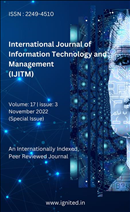The Impact of E-Advertising Strategy on Customer Buying Behavior: An Analytical Study
Main Article Content
Authors
Abstract
It's an approved fact that if a business wants to survive in the long run, it has to keep itselfupdated. Laggers are left behind when they stick to rigid traditional methods and are not able to keepthemselves going with the trends. With the advancement in technology, there is a shift from the traditionalmarketing strategies to digital marketing. There are various advantages associated with digital advertisingas compared to traditional methods of advertising the product or a service such as less cost, helps inbuilding customer base across the globe, boosting online sales and helps in growing brand loyalty. Thegoal of the research study is to analyze the impact of e- advertising on the buying decision behavior of theconsumer. With the advancement in technology and increase in the number of people engaged on socialmedia and other platforms as well as a shift in their preferences to buy online are important crucialreasons why no. of enterprises are taking a shift towards digital advertising. The secondary objective ofthe research is to analyze the consumer psychology and purchasing behavior while making onlinepurchases. The results of the findings depict that a positive change in the behavior of the consumer isseen via adopting digital advertising tools. The sales surely get a boost in the long run but this can notonly be attributable to only one factor but digital marketing strategies have an important role to play inthis regard. Thus the conclusion can be drawn from this study is that marketers need to be updated withthe technology and trends if they want to survive in the long run.
Downloads
Download data is not yet available.
Article Details
Section
Articles
References
- Adelaar, T., Lee, B. &Morimoto.M (2003). Emotions & Impulse Buying Behaviour,” Journal of Information Technology, 18, 247-266.
- Awobamise, A.O. &Jarrar, Y. (2019). Understanding the e-consumer buying behaviour: Introducing an online buying decision model. Journal of Advanced Research in Dynamical and Control Systems, 11(8), 3215-3225
- Awobamise, A.O. (2018). Increased Consumerism in a Networked-Nigeria: A Study on the Effect of E-Malls and Social Media on Youth Spending. Journal of Digital Media & Interaction, 1(2): 40-55
- Ayanwale, A.B., Alimi, T. &Ayanbimpe, M.A (2005). The influence of Advertising on Consumer Brand Preference. Journal of Social Science, 10 (1), 9-16.
- Backhaus, K. and Wilken, R. (2007). Predicting Purchase Decision with Different Analysis Methods, International Journal of Market Research. 49(3). Pp. 341-364
- Barkowitz et al (1992). Marketing, (3rd Ed.), Macdonald and Evans Ltd, London, U.K. Edition, Pearson Education Ltd.
- Bauer, H.H., Barnes S.J., Reichardt T., & Neumann, M.M. (2005). Driving Consumer Acceptance of Mobile Marketing: A Theoretical Framework and Empirical Study. Journal of Electronic Commerce Research, 6 (3): 181-191.
- Briggs, R., & Hollis, N. (1997). Advertising on the Web: Is there response before click-through? Journal of Advertising Research, 37(1): 33–45.
- Chadwick F.E.& Doherty N.F. (2012). Web advertising: The role of e-mail marketing. Journal of Business Research, 65: 843–848
- Ducoffe, R. H. (1996). Advertising Value and Advertising on the Web. Journal of Advertising Research. 36 (5):21–35.
- Flores, W., Chen, Jeng-Chung V. and Ross, W. H. (2014). The Effect Of Variations In Banner Ad, Type Of Product, Website Context, And Language Of AdvertisingOnInternet Users’ Attitudes. Journal of Computers in Human Behavior, 31:37–47
- Hensel, K. and Deis, M. H. (2010). Using Social Media to Increase Advertising and Improve Marketing. The Entrepreneurial Executive, 15: 87-95
- Jarrar, Y., Awobamise, A.O. &Aderibigbe, A.A. (2020). Effect of influencer marketing vs Social media sponsored advertising. Utopia y Praxis Latinoamericana, 25(Extra 12), 40-45
- Jarrar, Y., Okechukwu, L.E. &Awobamise, A.O. (2019). Attracting younger millennials: Lifting Bond out of a traditional sinkhole. Dirasat, Human and Social Sciences, 46(1): 115-123
- Kaplan,A.M. &Haenlein,M. (2010).Users of the world, unite! The challenges and opportunities of Social Media. Business Horizons, 53 (1): 59-68.
- Kim, C., Park, S., Kwon, K. and Chang, W. (2012). How to Select Search Keywords for Online Advertising Depending on Consumer Involvement: An Empirical Investigation, Expert Systems with Applications, 39(1): 594–610.
- Kotler, P. (2003). Marketing Management, 11th Edition, Prentice Hall of India Private Ltd, New Delhi, India.
- Kunz, M.B., Hackworth, B., Osborne, P., &High,J.D. (2011). Fans, Friends, and Followers: Social Media in the Retailers’ Marketing Mix. Journal of Applied Business and Economics,12(3): 61-68.
- Li, H., &Bukovac, J. L. (1999). Cognitive impact of banner ad characteristics: An experimental study. Journalism and Mass Communications Quarterly, 76(2), 341–353.
- Merisavo M., Kajalo S.,. Karjaluoto H, Virtanen V., Salmenkivi S., Raulas M., &Leppäniemi M. (2007), An Empirical Study Of The Drivers of Consumer Acceptance of Mobile Advertising, Journal of Interactive Advertising,7(2): 41-50.
- Neal, C., and Quester, P. (2006). Consumer Behaviour: Implication for Marketing Strategy, 5th Edition Berkshire; McGraw-Hill.
- Nwokoye, N.G. (2000). Marketing in Nigeria, 1st Edition, MacMillan Publishers Ltd, Lagos,Nigeria.
- Okiyi, G. O., Odionye, C., Emutumah, F. &Awobamise, A.O. (2020). Influence of advertising on Abuja women’s choices of e-commerce platforms. KIU Interdisciplinary Journal of Humanities and Social Sciences, 1(2), 53-67
- Romaniuk, J. & Sharp B. (2004). Conceptualizing and Measuring Brand Salience.” Marketing Theory Articles, 4 (4), 327-342.
- Schiffman, L. and Kanuk, L. (2007). Consumer Behaviour: An Overview Outlook; London: Pearson Education.

